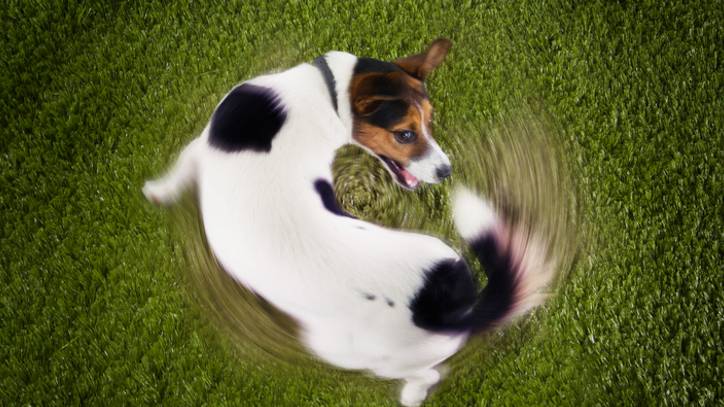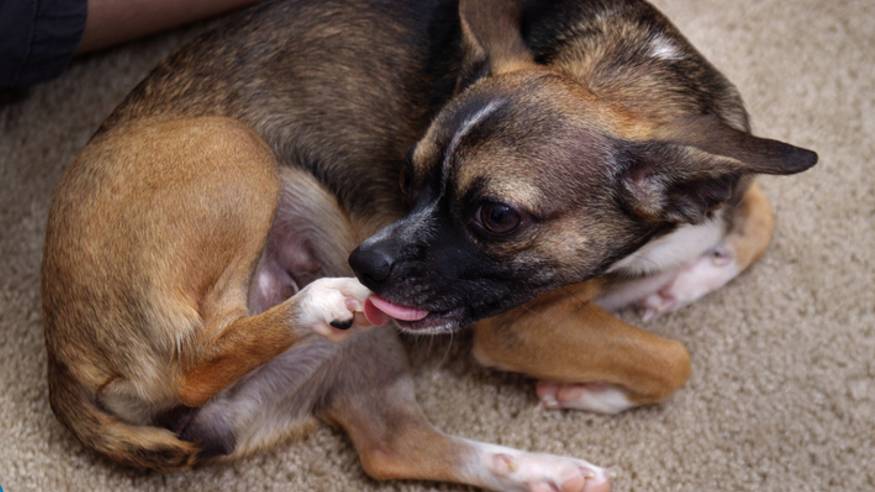OCD in dogs: Does it exist and what can resemble the condition?
Canine compulsive disorder shares many similarities with obsessive compulsive disorder in humans—keep reading to learn more about this condition

Obsessive compulsive disorder, or OCD, is a mental health condition that generally causes persistent, unwanted thoughts (obsessions) followed by repetitive behaviors (compulsions) in humans—but can dogs have OCD as well?
Canine compulsive disorder (CCD) shares many overlapping similarities with OCD in humans. It can be a lengthy process to diagnose CCD, so it is always recommended that owners take out pet insurance before getting a dog to help offset the financial burden of unexpected health conditions.
Let’s take a closer look at CCD, including its causes and how it is managed.
Can dogs have OCD?
Although dogs can have a condition similar to OCD in humans, it is generally referred to as “canine compulsive disorder” because, although affected dogs display compulsive behaviors, they cannot tell us if they are having obsessive thoughts.
Canine compulsive disorder is characterized by repetitive behaviors that do not have a clear purpose and persist regardless of the dog’s environment. These behaviors often stem from normal behaviors like grooming or movement, such as flank sucking or tail chasing.
Although many of these behaviors can be normal in the presence of a stimulating trigger like stress or boredom, dogs with CCD display compulsions frequently and may appear to have a lack of control over their behaviors.
What causes dogs to have CCD?
There is no single cause of CCD, but there are several factors that can contribute to its development. These include:
Get the best advice, tips and top tech for your beloved Pets
Genetics
Studies have found evidence that CCD can be hereditary in dogs. In addition, a study conducted at Tufts University identified a gene on chromosome 7 that predisposes dogs to develop the condition.
Certain breeds are more likely to develop CCD and display certain compulsions, such as spinning in Bull Terriers, flank sucking in Doberman Pinschers, and staring at shadows in Border Collies.
Brain abnormalities
Neurotransmitters such as serotonin and glutamate are suspected to be altered in CCD, thus affecting the ability of the brain to send messages to the rest of the nervous system.
Additionally, a 2013 study found that Doberman Pinschers with CCD had similar brain structural abnormalities to humans with OCD on magnetic resonance imaging (MRI) scans.
Extreme response to stress or frustration
When dogs have high anxiety or a lack of mental and/or physical stimulation, they may display repetitive behaviors to self-soothe or entertain themselves.
If their needs are not addressed in a timely manner, these behaviors can progress to CCD in some dogs.
Medical conditions
Some medical conditions cause dogs to exhibit compulsions that can eventually lead to CCD. An example of this is acral lick dermatitis secondary to issues like arthritis or skin allergies, which occurs when a dog continuously licks their legs or feet, causing hair loss, skin irritation, and sometimes even infection.
How do you know if your dog has CCD?
Dogs with CCD display compulsive behaviors that interfere with daily life, including circling/tail chasing, pacing, excessive licking, flank sucking, incessant barking, drinking excessive amounts of water, eating objects like rocks or feces, “fly snapping,” and freezing and staring.
Affected dogs may perform these behaviors in the absence of a stimulus or trigger. The condition usually appears in the first 2 years of life when the dog is a “teenager” or young adult.
There are several medical issues that can cause at least one of these behaviors, including seizures, toxin exposure, and skin conditions, so CCD can only be diagnosed once other underlying causes are ruled out.
If you suspect your dog may have CCD, your vet will take a thorough history, conduct a physical examination, and perform diagnostic tests like blood and urine tests.
They may also recommend further investigations including imaging (i.e., X-ray or MRI) or therapeutic medication trials with painkillers (i.e., tramadol or gabapentin), anti-inflammatories, steroids, or anticonvulsants. They may even prescribe prozac for dogs, known as fluoxetine hydrochloride

How is CCD managed in dogs?
Canine compulsive disorder is initially managed with environmental adjustments and behavior modification training. Providing a predictable daily routine and avoiding known triggers of compulsive behaviors can lessen stress and anxiety in dogs with CCD.
When a dog begins to exhibit these repetitive behaviors, they should be redirected to another activity, like training commands, and rewarded once they no longer display compulsions and calm down.
In addition, providing additional mental and physical stimulation through the use of puzzle toys or games and exercise can tire them out and relieve anxiety.
Although these changes can help some dogs when initiated early, most dogs with CCD (especially those with a genetic component) require medications to treat their condition.
The medications most commonly used to treat CCD include selective serotonin reuptake inhibitors like Prozac and tricyclic antidepressants like clomipramine, which are also used frequently in the treatment of OCD in humans. Dogs typically start to respond to these medications after 3-4 weeks of treatment.
Many dogs with CCD benefit from seeing a behavior specialist —your veterinarian may wish to refer you to a board-certified veterinary behaviorist if they do not find any underlying causes of compulsive behavior.

Dr. Diana Hasler graduated with distinction from the University of Edinburgh Royal (Dick) School of Veterinary Studies in 2018. She has experience working as a small animal veterinarian in general practice, where she has treated many dogs, cats, rabbits, and rodents. She has also recently branched out into the field of medical communications, doing freelance work as a medical editor and writer.
Can CCD cause aggression in dogs?
Aggression is often a displacement behavior when a dog experiences stress or anxiety, so dogs with CCD who are not managed properly may show signs of aggression if they are interrupted while performing compulsive behaviors. A study by Overall et al. found that 28% of dogs with CCD displayed aggression related to dominance or impulse control. Dogs with CCD may also direct aggression towards themselves and self-mutilate.
It is crucial that dogs with CCD are diagnosed and treated early to minimize the chances of them becoming aggressive for the sake of their owner’s safety and their own wellbeing.
Is CCD in dogs curable?
Like OCD in humans, CCD is usually a chronic, lifelong condition that cannot be cured. Luckily, it can be controlled with appropriate management, and dogs with CCD can live long, happy, and healthy lives.
Dr. Diana Hasler graduated with distinction from the University of Edinburgh Royal (Dick) School of Veterinary Studies in 2018. She has experience working as a small animal veterinarian in general practice, where she has treated many dogs, cats, rabbits, and rodents. She has also recently branched out into the field of medical communications, doing freelance work as a medical editor and writer. Dr. Hasler has been Postdoctoral Research Fellow at Michigan Medicine since 2023, where she is a Laboratory Animal Medicine Resident.

